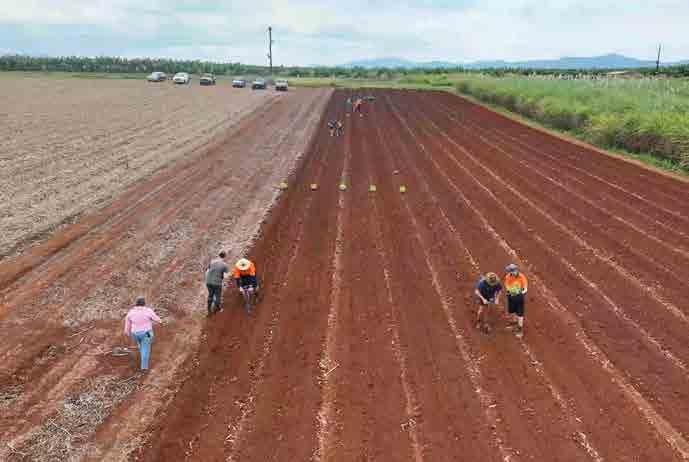
6 minute read
Taking control
BY RENEE CLUFF
An Innisfail cane grower has made tissue culture the foundation of his planting program.
Joe Zappala farms in Innisfail’s Mena Creek area on picturesque, unique red soil. The 100 hectares, predominantly under sugarcane but also papaya, contain the basalt-derived Eubenangee soil series, a Red Ferrosol of the Krasnozem soil group. Eubenagee soils make up just two-per-cent of the sugarcane area in the Johnstone catchment and are considered a rarity nationally and globally due to their physical and chemical properties.
“One of the major properties is they have a very tight bonding of phosphorous so the application of phosphorous is critical and it can get locked up in our soils very quickly,” Joe explained. “Our Phosphorous Buffer Index (PBI) on our best soil is probably about 450 and on our most difficult soil it can be up to 700 to 800 PBI.
That’s unheard of in most places around Australia
The volcanic Eubenangee soils are fertile because of their topsoil structure and ability to hold nutrients. They’re also naturally acidic and despite having a high clay content, are considered a sandy clay and drain quickly. Because of these divergent properties, sugarcane variety selection is vital, and Joe describes access to a choice of varieties as crucial for productivity.
“Soil nutrition is one thing, but our biggest challenge at the moment in our area is varieties,” he said. “In the red soils it’s a bit more difficult because there are more challenges in regards to drier soils when the rain stops, and you need a good cover and good trash blanket for weed and erosion control.”
Access to new varieties has posed a problem for Joe in recent years, which he says dates back to the smut incursion of the late 1990s. “There are a couple of promising varieties now, but that is something we have lacked for a very long time,” he said.
“After smut came into the industry, SRA had to change the breeding program because of susceptibility to smut and they more or less had to target smutresistant varieties.

That had to happen, but we have sacrificed a lot in our productivity. Our yields and CCS aren’t indicative of the potential of our soil types.”
About eight years ago, a lack of access to newer varieties was in part why Joe began planting tissue culture trials. However, this initiative transitioned to become a permanent part of his planting program, as he sought to prevent disease. “Initially, I dabbled with tissue culture a little bit, but I predominantly used to get whole stick cane from the local productivity services,” he said. “In 2018-19, SRA26 was released in this area. I planted in clean ground only to find it was infected with RSD.
“That really put my planting of SRA26 back two years. That’s cost me a fair bit of money because subsequently, we have learned that SRA26 is a good producer and returns good dollars per hectare for the growers.
Fortunately, Joe was well set up to plant tissue culture because he also has a horticulture crop. The seedling planters he uses to plant papaya are also suitable for the sugarcane seedlings. This method is now being replicated across the Johnstone catchment through the Cassowary Coast Reef Smart Farming program, which is also planting tissue culture to accelerate adoption of the newer, higher-performing varieties.
I needed to take back control
Joe said the irrigation system he has for the papayas can water the sugarcane seedlings, too. “I only plant about 200 metres of tissue culture,” he said. “It’s quick and easy and then I run drip tape off one of my main lines to irrigate it, so I water it every time I water my papaya.
“Weed control can be an issue so what I use is something like S-Metolachlor over the top of the tissue culture, it doesn’t seem to affect it too much. I do not use Paraquat. If there are some broad-leaf weeds, I might put a bit of 2,4-D with it or a bit of MCPA depending on the weed pressure or the weed type.

Joe continues to plant tissue culture for his own seed plots simply because it’s easier and more efficient.
“If I can plant 200-metres, I can get equivalent to two whole stick cane trailers the following year,” Joe said. “That’s enough multiplication of clean seed material to keep me moving. I can rapidly escalate my volumes.
It’s not cut and dried, you’ve got to adapt as you go
With whole stick, there’s a bit more involved, especially when it comes to transporting that material from the productivity board plot to my farm, which isn’t easy and involves crossing the Bruce Highway. I find I can get enough in trays of seedlings.”
The papaya and cane also work in tandem through Joe’s fallow cropping system. Papayas are planted as a break crop to regenerate blocks over a two-year period. The other big bonus is that the papayas also earn an income for Joe’s enterprise.
“There’s no point having ground sitting there and not earning you an income or costing you money because you’ve got to keep it clean or plant a legume crop,” he said. “I plant papaya and it’s probably the best situation for the soil because it’s a totally different crop, you’re following totally different management practices, and it reduces a lot of pathogens in the soil.
“Nutrition also has to be more spot on with papaya so you’ve got to get your pH right and they use a little bit of fertiliser so you build your nutrition up in your soil. When I plant a sugarcane crop after papaya, I don’t have to top dress with potassium or urea, I just use DAP fertiliser at planting and that’s it and I usually get a very good crop. The nutritional capacity of the soil is a lot better.”









